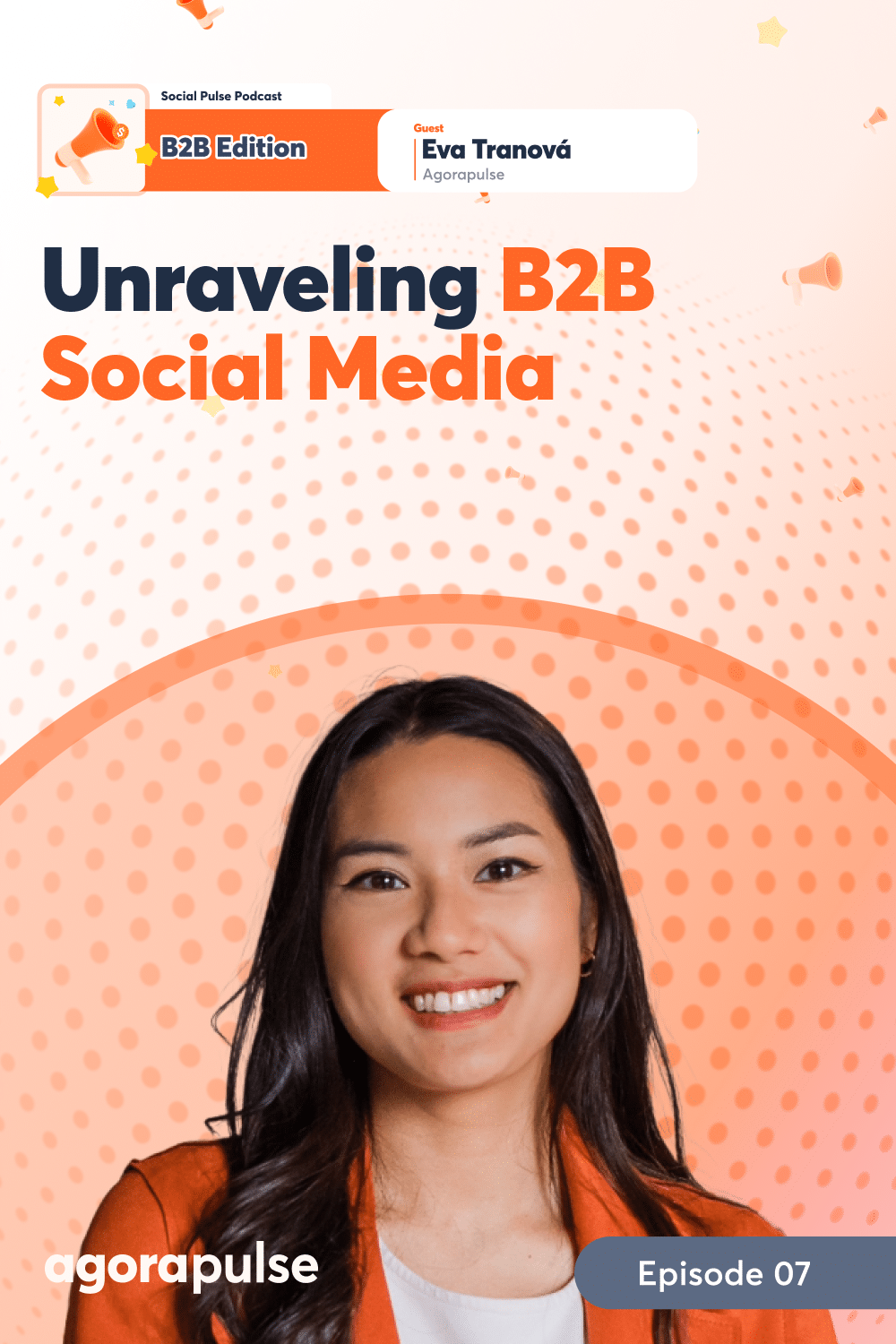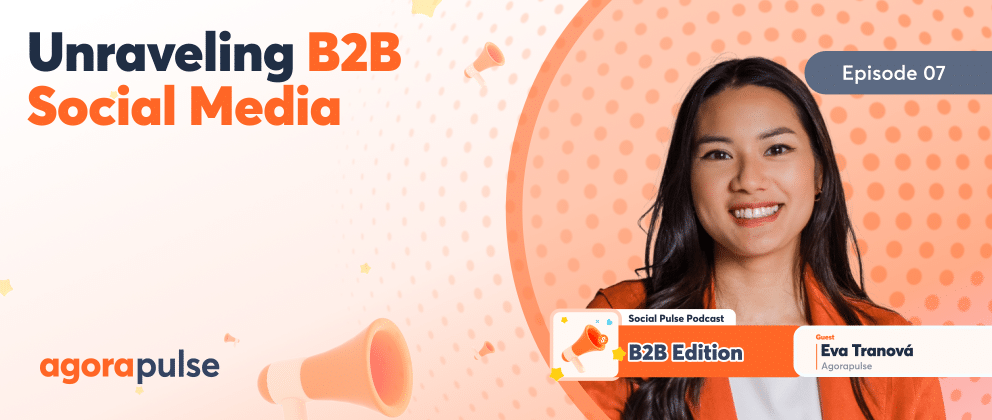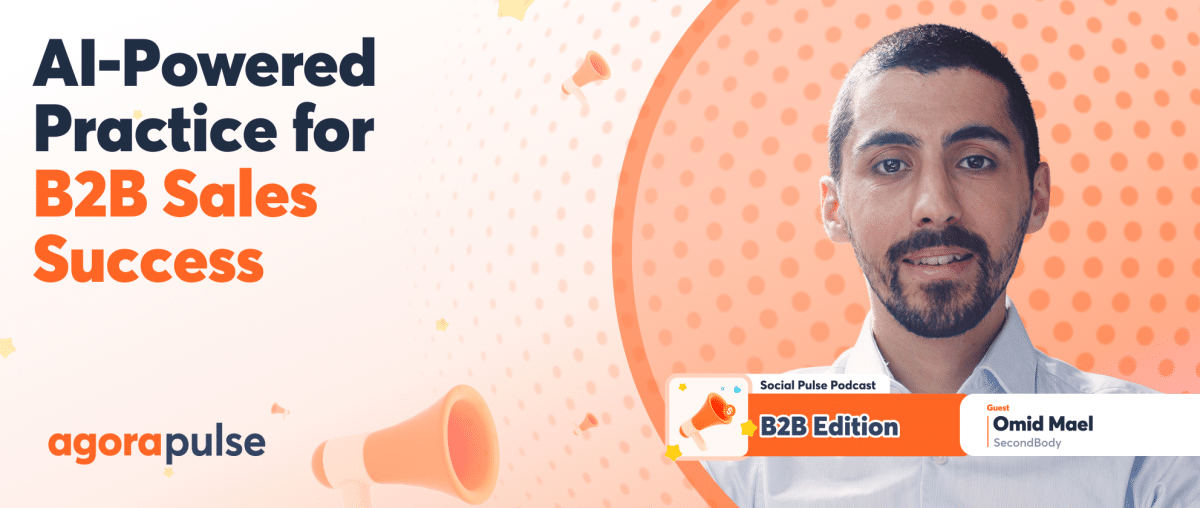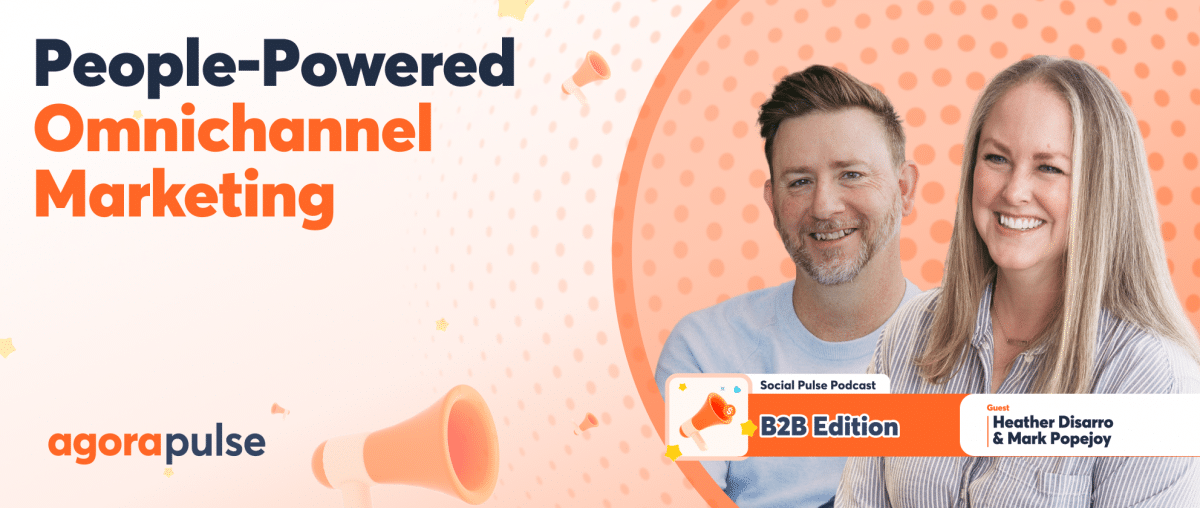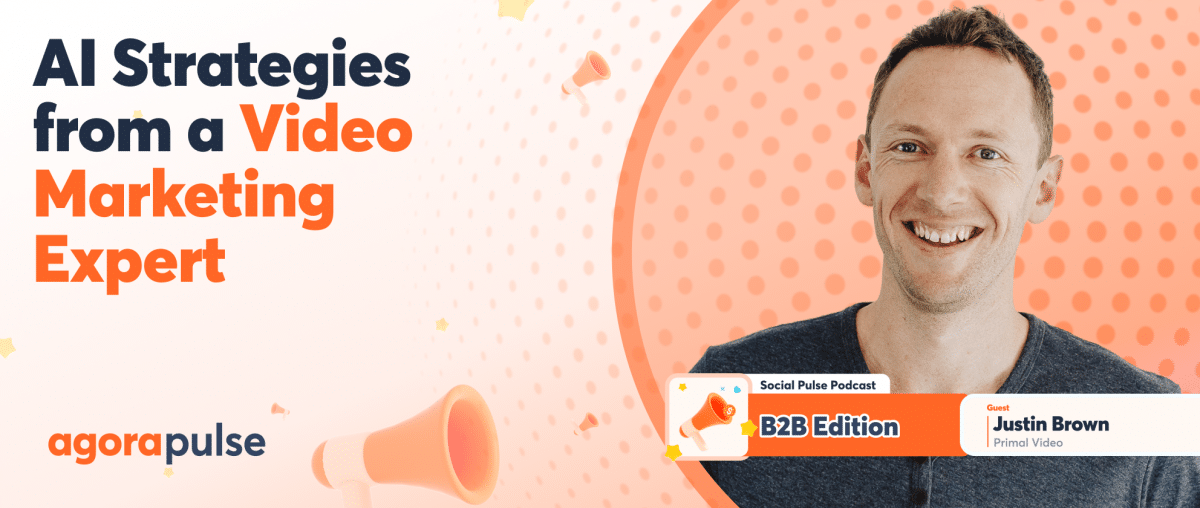Do you wonder why strategies that work for B2C brands fall flat for your B2B? Many B2B social media managers face challenges that can leave them feeling frustrated and unsure of how to proceed: How do you create engaging content for a seemingly dry industry? How do you measure ROI when your sales cycles are long and complex? And how do you build meaningful relationships in a landscape where decision-makers are notoriously hard to reach?
These are the puzzles that may keep B2B social media managers up at night. But what if there were ways to not just overcome these obstacles but turn them into opportunities for growth and engagement?
Eva Tranova, the head of social media at Agorapulse, brings a wealth of experience and insights to our discussion with her multilingual background and expertise in social media marketing in this episode of Social Pulse Podcast: B2B Edition, powered by Agorapulse, with our Chief Storyteller Mike Allton.
Biggest Challenges
What are some of the significant challenges that you’re facing, that other B2B social media managers are facing, particularly compared to our B2C counterparts?
Eva Tranova: I regularly have conversations with other B2B social media managers.
The thing that we all agree on is the fact that how to make sure that we reach our target audience, how to make sure that our content is authentic, and that’s often that big challenge compared to B2C.
- Another big challenge is, of course, that within the B2B sector—especially when speaking about Agorapulse, for example, or the SaaS product industries—it’s difficult to have visually engaging imageries compared to, let’s say, the design industry or beauty and fashion sector.
- These are the typical challenges in terms of content that the B2B social media managers typically encounter—and this is also something that I encountered when I started here working at Agorapulse—but I think there are new opportunities, as well for us to stay within this and to be even more creative because we have the field of opportunities, it’s more maybe limited from the first approach.
- But then if we think about it more and you do this research, you understand the pain points of your customers, but also the strengths that your company has then there is so much more that you can do with it. But you just need to dive in and see what’s working and what’s not working.
But definitely overall for the B2B sector, it’s about being able to reach the customers and share authentic content that resonates with them.
How do you see B2B brands creating engaging content for industries despite being boring or technical?
Eva Tranova: Well, the boring and technical—that’s where the challenge starts, but also the opportunities.
I think the key to success here is leaning into personal branding and people-centric content because what makes a difference in the B2B sector is not a great carousel post that you would share, but actually the human approach because we as humans are so unique.
Each of us brings a different element to the commercial aspects, all of this. So I think leaning into personal branding and leveraging all those specialist experts B2B companies have in-house is the key to success in B2B for the B2B businesses, but not all B2B brands are doing it because it’s a big leap. It takes time.
You have to take time to do the internal marketing. Social media managers working within B2B brands need to explain why they want to bring other employees on social media to talk, to create content with them.
So I think, yes, the key is including people because “people always connect to people.” That’s a quote from Amelia Sordell, one of the CEOs of Klowt Agency. And that human approach changes everything within B2B. So even though you have a very, let’s say, boring or technical topic, the human aspect can make a real difference in getting employees to show up and be on camera. It is a real challenge because first of all, it’s not part of the role, right?
Not everybody feels comfortable in front of the camera. So, we need to cherry-pick those that are willing to do so, that have the talent to do so. Usually, the sales team would be more inclined to do so because they’re already. They’re so out there speaking to different people, speaking to your customers, so they might be less shy as well.
I would say, let’s start with the salespeople, with the commercial team, and through them, you can then build your case, have the first success stories, and then push it further with other members of your team as well.
Mike Allton: That’s a great approach. And I couldn’t agree more with your overall strategy of having that people-first presence. It’s something, you know, Mark Schaefer, a longtime friend of mine and keynote speaker, he’s been talking about bringing that humanity into branding for years. Pre-AI, which is saying something, but I’m wondering, because we talked at the outset about how there’s also a challenge of reaching the decision-makers.
What strategies have you found most effective for reaching decision-makers on social media platforms?
Eva Tranova: So the strategy that I found most efficient is through thought leadership. So it could be your CEO or the C suite or as well, also influencers as specialists that are very vocal about the topic, the subject that is related to your brand.
So using them to reach those decision makers because they have years and years of experience within the field. And they surely already have that network. So especially let’s say LinkedIn that works on networks and connections. If an influencer or let’s say a CEO shares content that is very knowledgeable and brings new insights into a topic, then all his connections will be notified about it.
It will reach different decision-makers as well. So it’s through that top-down approach that I think you can reach thought leaders and senior people within the industry.
Mike Allton: And one of the things that I think what you’re saying really speaks to is the complexity of sales in the B2B world where, yeah, you might have a C-suite executive or somebody like that, who’s the ultimate decision maker.
Social Media Strategies
But to your point, you’ve got several other people in that process and that makes it not only more complex but more time-consuming. How have you seen that come into play when it comes to your social media strategies? How can social media managers align their efforts with these longer sales cycles in these complex buying processes?
Eva Tranova: Well, I think as you mentioned the sales cycles are so long. The touch points are also multiple. So, your prospect might have seen your content or social media. Then the person might have Googled you, then might have listened about you through a podcast. They might have downloaded an ebook.
So, it is not just one source and then conversion right away, but so many different touchpoints. And I think the key here is to always communicate the progress, the journey of your work using data reporting, and regularly on a monthly basis, communicating all those efforts with your team or with your senior leadership team so that they are always aware of the efforts, and they also understand that B2B sales cycle are long.
So, they know if you manage the expectations and over-communicate and under-communicate, then I think this would help B2B marketers to reach their goals and also put themselves in the place of the key players who are senior enough, who are constantly communicating the process of the campaigns.
What NOT to Do
What are some other common mistakes that you’re seeing B2B brands make on social media, and how can they be avoided?
Eva Tranova: I think the mistakes I keep seeing are basically brands being too corporate, too official, and speaking too much about themselves.
The posts that I typically find are quite vanilla. We are pleased to announce that we are launching this and this product or service. Well, okay. This is nice for a brand, but how about your target audience? What excites them? What is the thing that they are looking for?
I think it’s when brands are too focused on themselves, their agenda, their program, and they forget their target audience. That’s the main mistake that I can keep seeing here, and the brands that succeed are those that put themselves in their target audience’s shoes. And they also are willing to be a bit more creative. They are pushing the boundaries, and they think outside of the box.
Let’s go back to video content, so instead of just posting an image saying, “Oh, we are pleased to announce the release of this,” if it’s a feature service, then using video content, featuring your team members, talking about the pain points of your target audience can make a real difference. So, taking things further there will make a real difference, and not being lazy, not just writing a post and hitting send.
[Don’t miss out on brand NEW episodes of Social Pulse: B2B Edition, where each and every week we’re talking to marketing professionals like you going through many of the same struggles you’re going through and sharing their stories.
Subscribe to find on each episode, the inspiration, the motivation, and the perspiration that go into growing and scaling organizations like yours.]
People need to make more effort in the content they are creating and always put themselves in the shoes of the target audience.
And that’s what we do a lot at Agorapulse as well. We understand the pain points of social media managers and community managers. We understand what can make their lives easier. So from reporting, publishing, [and] proving the value of the work, all of this is always part of the conversation. It’s always on my to-do list of things I need to think about when I create content for Agorapulse.
And I’m sure this is something also that you consider all day long when you speak with your industry peers. I mean, when you attend events, you always try to think about the target audience.
What are the solutions we can bring to help them?
Mike Allton: Absolutely. There are two core truths, I think, that you’ve shared there.
- The first is the idea that we have to know who our target audience is. And I think that’s a step that far too many businesses and marketers overlook: well defining that target audience so that they understand their pain points. They understand what our previous guest: Tamsen Webster talked about their goals and aspirations. We don’t always have to trigger our target audience with pain points. And we can talk to them about what they want to accomplish, where they want to be. How can we help you get there as a brand? And you can’t do that if you haven’t had those conversations and gone through the process of documenting an ICP or persona.
- But the other thing that you said that I think was really, really true is you talked about how not enough brands or marketers are going to the extra effort of creating video. I think the real core truth there is that they’re afraid. They’re afraid that, well, first of all, they might look bad on video. We all have that issue, right? We’re afraid of appearing on video. I’ve been battling that—I will be transparent—for years, this is not a comfort level for me, even today, despite all the videos that I do. And I know that that’s true for everybody, at least to start.
And then there’s also that fear that you were creating a video on behalf of the brand. Is that going to perform? Well, there’s more effort that goes into it, that sort of thing.
I don’t know if that’s something you’ve battled with either in your current role in the past or how you’ve maybe worked around that or overcome that.
Eva Tranova: Yeah, that’s a good question. And I think practice makes perfect. Some people just have the natural ability to appear in front of the camera, and some don’t. I don’t. But I try to always push myself, and it can always only go better. You learn from your mistakes, you improve, and then you analyze, and get better, and that’s how it goes.
You just have to put yourself out there because otherwise, you can read books and watch videos about how to make videos, but until you actually try it, you won’t know because it’s so personal to each of us. So, you might be repeating specific words. You might be using your hands too much. You won’t know until you try.
Mike Allton: That is exactly right. In fact, [in]our Agorapulse TikTok channel or Instagram Reels, and [you’re] creating some really interesting videos that are in line with what those platforms are expecting.

Success Stories
Mike Allton: One of the things that I love is when people are able to share very specific stories and use cases because it helps us understand in practical terms what is it we’re talking about.
How has Agorapulse or one of our B2B customers overcome some of these significant social media challenges that we’ve been talking about today?
Eva Tranova: Yes, definitely. So one of the examples of Agorapulse using Agorapulse and our features is, for example, the advocacy feature we use for recruitment.
When we are looking for the ideal candidate, we work with the HR team to share those posts on social media, especially LinkedIn.
- What our advocacy feature allows you to do is to create a curated list of advocates, internal and external, and then you can link to your post through the advocacy feature and they will receive it in their email addresses. And then they can share, like, and comment on your post on social media.
- LinkedIn works super well for us because last time the CEO shared an advocacy post because we were looking for a website manager, and we found one, thanks to that. And so he sent us that advocacy email, and we all re-shared it with our network. We commented for more reach. So this is one of the examples we internally use: the advocacy feature.
Another example I can share is one of our clients who is a big corporation, and they have one major mark. They have a marketing person who leads the whole department, but they also have smaller branches and for each brand, they have their own marketing coordinator.
So, this main person, the marketing manager who works within the central team, would use the advocacy feature to share content with the marketing coordinators of each branch. And she would share a different … corporate messaging so that the others could also share it on their LinkedIn profiles as well.
So again, it helps you amplify your reach and increase your engagement as well, especially on LinkedIn, where you really, really want people to see your content and engage with it. This feature is really, really helpful for the B2B sector. I know that we have been also using that to promote this podcast and it’s been working very well. So, our diffusion list of external collaborators has been also sharing our podcast and it definitely helped spread the word about this amazing podcast.
These three examples … are the main examples of how we use the advocacy feature.
Mike Allton: I love those examples.
In fact, I was just doing a walkthrough video with Adobe, and we’ll link to that in the show notes for you guys because I walked through step-by-step and showed on screen a demo of how to use our advocacy feature for both internal and external advocates.
Best Practices
What do you think in terms of the importance of employee advocacy, particularly when it comes to B2B brands and their social media efforts?
Eva Tranova: Yeah, it’s really important because if we go back to personal branding and that people-centric approach.
At the beginning, the employees might feel a bit resistant to posting content themselves … So actually employee advocacy can be the first step for them to just reshare comments under your post, so it can be that entry-level kind of thing for them to start their personal brand, to start engaging that with the branded content.
What role do you think that plays particularly in refining B2B social media strategies?
Eva Tranova: Analytics is the backbone of everything we do because you can be sharing content out there, brainstorming about the best ideas. But if you don’t have analytics to have that feedback about whether your content works or not, then you’re just shooting in the dark, right?
So at Agorapulse, what I do is, every month I can easily generate monthly reports. I can just click and click on a button, and it just creates itself. So I can receive that in my email. And then I can see all the information about our demographics, target audience, the best-performing posts, the best data posts as well for engagement, and so on, so on, so on, depending on the platform that I’m pulling the data from.
From that, every time at the end, at the beginning of the month, I would just sit down and see what type of post work, which one didn’t work, and then I can just refine the next month accordingly. And if I didn’t have the reporting, it would just be shooting in the dark, as I said.
Also, if you just go natively the data you have available is quite limited, and everything is so manual when you go into the inside section of Instagram, you have to write everything down manually. You can’t just click a button and explore everything in your expert Excel sheet.
I think having this process automated saves so much time, and you can then easily analyze everything and gain new insights for your next month.
Mike Allton: Talk to me about the additional tracking capabilities that Agorapulse has when you’re sharing blog posts, job openings, events, these kinds of things.
What else does Agorapulse do for us in those kinds of situations?
Eva Tranova: That’s a good question.
- We have track URL links within Agorapulse that you can generate actually within the publishing window. So let’s say that you write a post, create a post for LinkedIn, add a URL link, and then you can actually click on a button that tracks your link.
- You can also create a UTM link. So you can give a name to your campaign and so on. And then by the end, at the end of the month, you can see which posts converted or not. So that’s one.
- And then we have this super powerful feature called Social Media ROI, which basically brings everything together. And it’s amazing because you can all also see which platform had the most conversions. Let’s say it was LinkedIn that brought more people to your website than Twitter. Let’s say, then that you should be focusing all your efforts on LinkedIn.
- You can also define the value of the event because it is connected to Google Analytics. So basically you don’t need to all the time go to Google Analytics. You just need to set it up correctly. And then it just runs by itself. And every month you just have the data available. That has been a game changer for me because I would naturally be more, for example, focusing on Instagram, but actually, it’s LinkedIn for us that works so well.
- That’s why for two months now, I’ve been focusing on LinkedIn, and I think that helps you also focus your resources and not waste your time somewhere else. And reach also reach your target audience because if your target audience is active on Linkedin, let’s say, then you should be there and you should be creating content that resonates with them
Mike Allton: Yeah, that Google Analytics integration is huge. Being able to bring that data back into the social media reports that you’re providing to your manager, those of you listening [and reading], you need to provide reports to your boss and your C-suite executives and be able to show off, “This is what we did last month.” And you’re able to draw a direct line between specific social posts and specific activities that happen on the website. And, honestly, one of my favorite points is that it automatically tracks links that you might share in a comment or even a direct message.
All of a sudden, dark social isn’t so dark anymore. We can track all that activity and behavior and results.
I was hoping you could share with us a little bit of behind-the-scenes in terms of how you are getting ahead as a social media manager.
Resources/Tools
What are some of the resources or tools that you’re recommending or using that B2B social media managers like yourself who want to stay ahead of industry trends and best practices could lean on?
Eva Tranova: So the first one I use is our internal one that is called Social Media Trends, which is free for everyone. It is a report that shows you the trends for each platform, so LinkedIn, Facebook, Instagram, and X, Twitter. You can adjust the region where you are. So that interests you.
Let’s say I am interested in LinkedIn data in France and also the specific industry, I can do that. I can just click on those folders, and it will show me the best days to post for engagement and the best type of content that actually engages people on that platform. So let’s say on Instagram, people might have been posting a lot of photos, but it’s video content that is working well on Instagram. So this is something I use also to inform my posting for next month.
So that’s our internal tool that is free for everyone. I would definitely recommend social media managers to test it out. And if not, I also share updates about that tool every month on our social media platforms. So you can always find it there.
The second resource I use is naturally Social Media Today. So I know this is not specifically B2B, but it’s good for every social media manager just to stay ahead of all the trends that are happening because none of the updates and trends are happening in isolation. So it’s good for you to understand the overall background and overall context.
The other source that I use is, of course, LinkedIn, where I follow a lot of marketing experts, and social media people who share, first of all, all the updates, but also their thoughts and learnings about the development of social media.
I think you also follow many of the ones that I follow. So Annie-Mae Hodge for example, is one of my favorites because every week she’s sharing the top updates on social media, Matt Navarra. Of course, it’s one of the classics. There’s so, so, so many of those, but I think it’s good for social media managers to curate their own LinkedIn feed by following the companies they’re interested in and the social media professionals that they admire and that they’re inspired by so that they can always stay on top of everything.
And, of course, different newsletters. It depends on your specialization in the sector, but then the B2B that you’re focused on always dedicates that time every week to learn about the industry updates and about the algorithm updates because it’s now happening on a daily basis.
Thank you all of you for listening. We’ll have all the links and all the resources that we talked about today in the show notes below. And don’t forget to find Social Pulse Podcast B2B Edition on Apple and drop us a review. We’d love to know what you think. Until next time.
